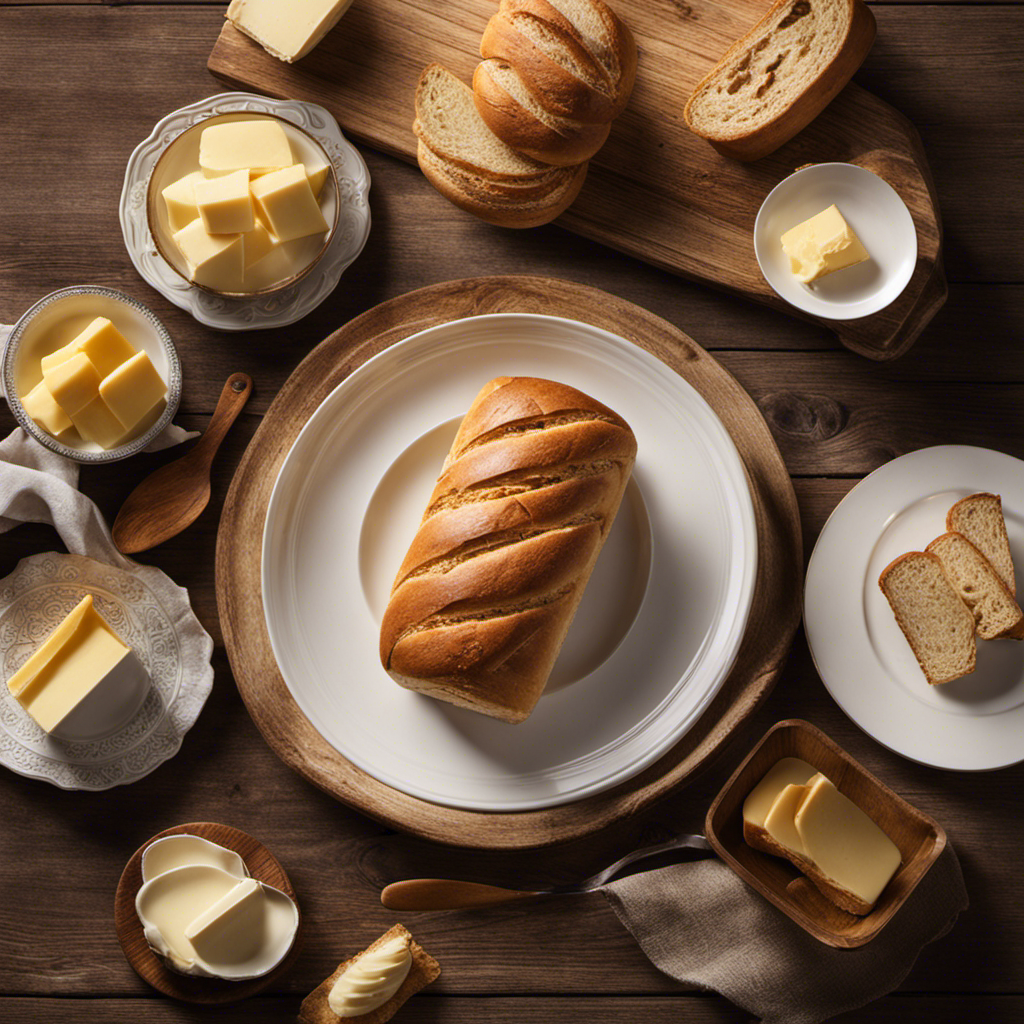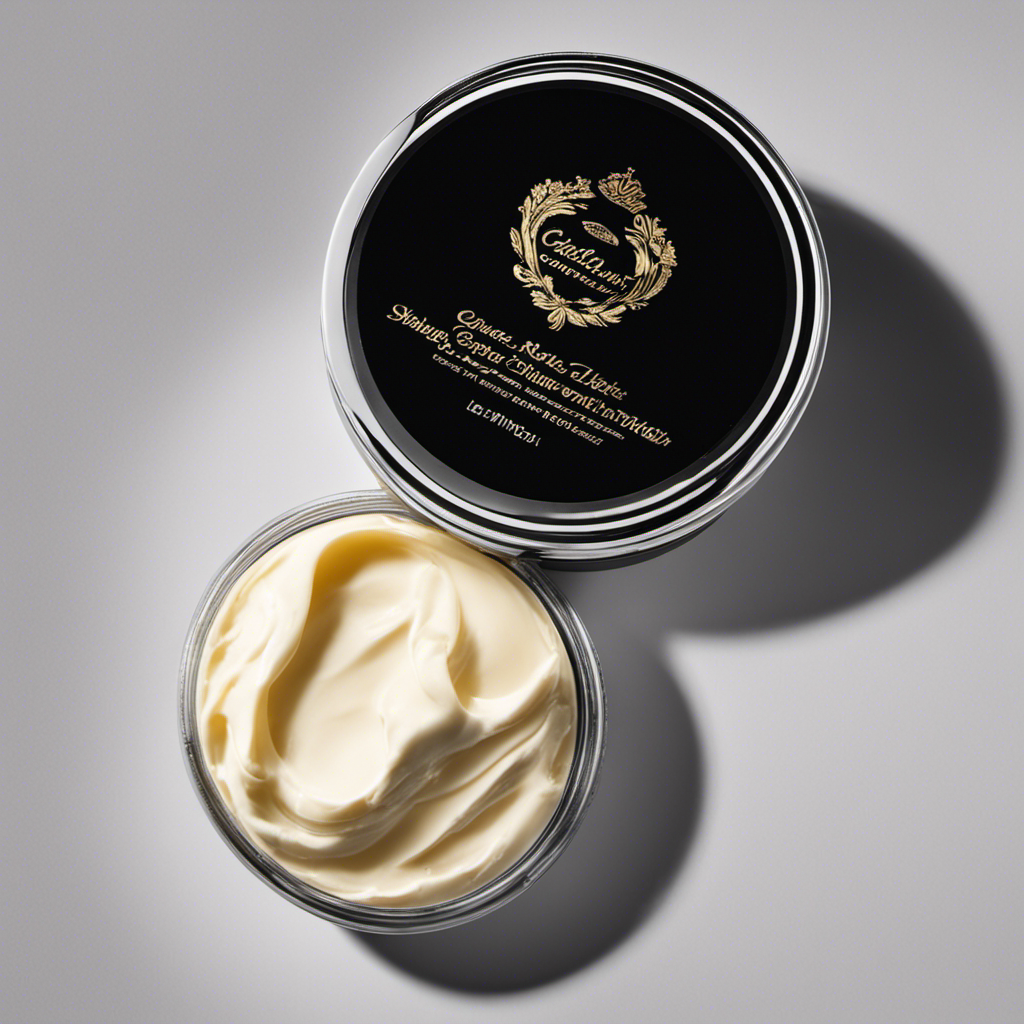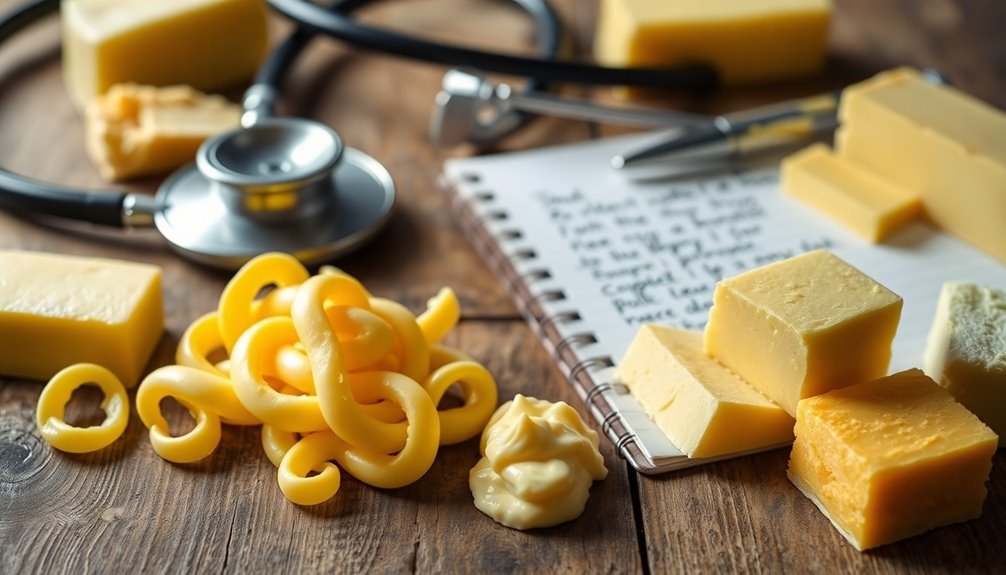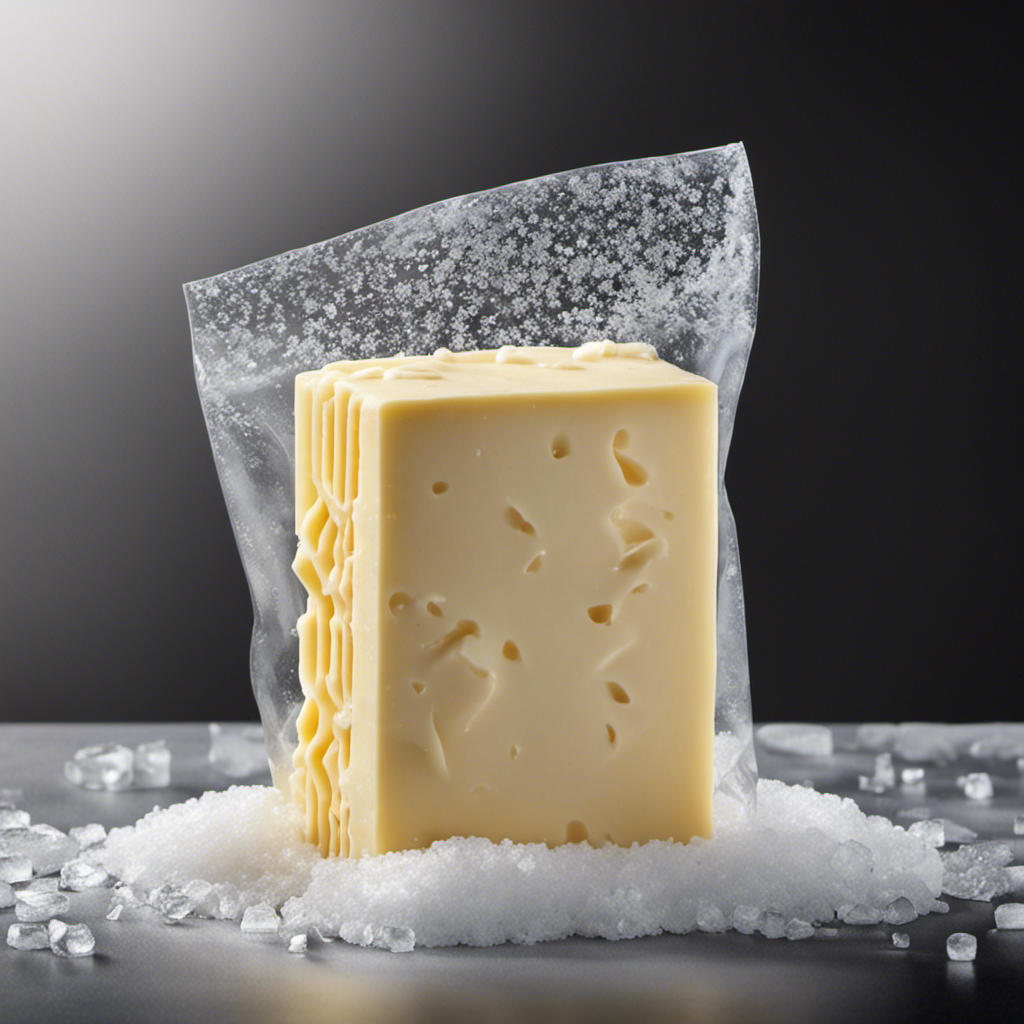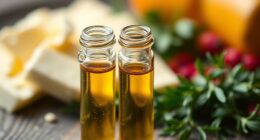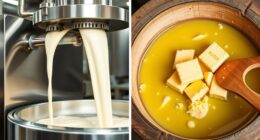I have always been intrigued by the wide variety of real butter brands available in the market.
Did you know that butter consumption in the United States has been on the rise in recent years? With so many options to choose from, it can be overwhelming to determine which brand is the best.
In this article, I will explore the history of real butter brands, factors to consider when choosing one, and popular brands worth trying.
So, let’s dive in and discover the world of real butter together.
Key Takeaways
- Land O’Lakes and Challenge Butter are recommended brands for baking, cooking, and spreading.
- Kerrygold butter is a good option for those managing weight or lactose intolerance.
- Organic Valley offers organic butter made from cows raised without antibiotics or synthetic hormones.
- European butter brands like Kerrygold, President, Lurpak, Elle & Vire, and Beurre d’Isigny are known for their rich flavor and are suitable for baking, cooking, and spreading.
The History of Real Butter Brands
The history of real butter brands can be traced back to ancient civilizations. Butter has been a staple in human diets for centuries, with evidence of its manufacturing dating back to as early as 2,000 BC.
Traditional butter making techniques involved churning cream or milk until the fat separated from the liquid, resulting in the rich and creamy substance we know today. Over time, different regions developed their own unique methods of butter production, incorporating cultural influences and local ingredients.
These traditional techniques were passed down from generation to generation, ensuring the quality and taste of the butter remained consistent. Today, real butter brands continue to honor these ancient traditions, producing high-quality products that showcase the rich history and craftsmanship of butter manufacturing.
Factors to Consider When Choosing Real Butter Brands
Consider factors such as taste, texture, and price when choosing which brand of real butter to buy. Real butter offers various health benefits and nutritional content that make it a popular choice for many.
When it comes to taste, different brands may have slight variations in flavor profiles, ranging from creamy and rich to slightly salty or tangy.
Texture is another important factor to consider; some brands may be softer and easier to spread, while others might have a firmer consistency.
Price is also a consideration, as the cost of real butter can vary depending on the brand and packaging.
Ultimately, finding a balance between taste, texture, and price will help you choose the perfect real butter brand for your needs.
Now, let’s explore some popular real butter brands in the market.
Popular Real Butter Brands in the Market
When it comes to choosing the best butter brands, it’s important to consider both taste and health benefits.
Some popular options in the market include brands like Kerrygold, Organic Valley, and Land O’Lakes.
However, it’s also crucial to look for the healthiest butter options, such as grass-fed butter or those that are free from artificial additives and preservatives.
Best Butter Brands
You should definitely try out some of the best butter brands available in the market. While butter substitutes are becoming more popular, there’s nothing quite like the taste and texture of real butter.
However, if you’re looking for alternatives, there are some great options out there. Additionally, making your own butter at home can be a fun and rewarding experience. There are countless homemade butter recipes available that allow you to customize the flavor and add your own personal touch. From simple salted butter to flavored variations like garlic or herb-infused butter, the possibilities are endless.
So, whether you’re a fan of traditional butter or looking to explore different substitutes and homemade recipes, there’s something for everyone.
Now, let’s dive into the discussion of the healthiest butter options.
Healthiest Butter Options?
If you’re looking for healthier options, there are some great alternatives to traditional butter available on the market. These alternatives provide various health benefits and offer a different nutritional content. To help you make an informed choice, here is a comparison table of some popular healthier butter options:
| Butter Alternative | Health Benefits |
|---|---|
| Coconut oil | Boosts metabolism, improves digestion |
| Avocado oil | Rich in monounsaturated fats, promotes heart health |
| Ghee | Lactose-free, supports digestion |
| Olive oil | High in antioxidants, reduces inflammation |
| Almond butter | Good source of protein and healthy fats |
These alternatives not only offer a healthier option but also provide unique health benefits. However, if you still prefer real butter, there are some organic brands worth trying.
Organic Real Butter Brands Worth Trying
One of the organic real butter brands worth trying is Organic Valley.
When it comes to health benefits, Organic Valley butter stands out. It is made from organic milk, which means that the cows are raised on organic pastures without the use of synthetic pesticides or antibiotics. This ensures that the butter is free from harmful chemicals and retains its natural goodness.
In terms of cooking techniques, Organic Valley butter is versatile and can be used in a variety of ways. Its rich and creamy texture adds flavor and richness to baked goods, sauces, and sautés.
Whether you’re baking a batch of cookies or sautéing vegetables, Organic Valley butter is a great choice for enhancing the taste and texture of your dishes.
Traditional Vs. Artisanal Real Butter Brands
When it comes to choosing between traditional and artisanal real butter brands, there are several key factors to consider.
Firstly, taste and texture play a crucial role in determining the overall quality of the butter. Traditional brands often offer a rich and creamy flavor, while artisanal brands tend to have a more unique and complex taste profile.
Secondly, the production methods used by these brands can greatly impact the final product. Traditional butter is typically made using a simple and straightforward process, while artisanal butter is often crafted using more intricate techniques.
Lastly, price and availability are important considerations for consumers. Traditional brands are generally more widely available and affordable, while artisanal brands may be harder to find and come at a higher price point.
Taste and Texture
You’ll notice a significant difference in taste and texture between different real butter brands. Real butter, made from cream, has a rich and creamy flavor that is hard to replicate with butter alternatives. The texture of real butter is smooth and velvety, allowing it to melt seamlessly on warm toast or baked goods.
Here are three key factors that contribute to the taste and texture of real butter:
-
Quality of ingredients: Real butter brands use high-quality cream, resulting in a superior taste and texture.
-
Churning process: The traditional churning process used by real butter brands helps create a creamy and smooth consistency.
-
Butterfat content: Real butter contains a higher percentage of butterfat, which enhances the flavor and richness.
Using real butter has several benefits, including providing essential nutrients, enhancing flavors in cooking and baking, and contributing to a satisfying and indulgent eating experience.
Production Methods
To achieve the desired taste and texture, it’s important to consider the production methods used in making butter. The production techniques play a crucial role in determining the quality of the final product.
Traditional butter production involves churning cream, which separates the fat from the liquid, resulting in butter and buttermilk. This process can be done using a manual churn or with the help of machines in modern factories. Regardless of the method, the key is to agitate the cream until the fat globules clump together and form butter. This ensures a rich and creamy texture.
In terms of nutritional benefits, butter is a good source of fat-soluble vitamins like vitamin A and E, as well as fatty acids that support brain health. However, it should be consumed in moderation due to its high saturated fat content.
Price and Availability
Looking for a good deal on butter? Check out local grocery stores for competitive prices and availability. Here are a few things to consider when comparing prices and availability in different regions:
-
Seasonal variations: Butter prices can fluctuate depending on the time of year. During peak dairy production seasons, prices tend to be lower due to increased supply.
-
Store promotions: Keep an eye out for special discounts or promotions at your local grocery stores. They often offer competitive prices on butter to attract more customers.
-
Regional differences: Prices and availability can vary from region to region. It’s worth checking prices at different stores in your area to find the best deal.
Transitioning to the next section about ‘real butter brands for baking purposes’, it’s important to consider these factors when making your purchasing decisions.
Real Butter Brands for Baking Purposes
When it comes to baking, your best bet for real butter brands is to check out options like Land O’Lakes or Challenge Butter. These brands are known for their high-quality butter that adds a rich and creamy flavor to your pastries.
When choosing the best butter brands for pastries, it’s important to consider the difference between natural and processed options. Natural butter is made from cream that has been churned, while processed butter undergoes additional steps for preservation and consistency.
While both options can be used for baking, natural butter tends to have a more distinct flavor and is often preferred by pastry chefs. However, processed butter can provide a smoother texture and longer shelf life.
Ultimately, the choice between natural and processed butter comes down to personal preference and the desired outcome for your pastries.
Real Butter Brands for Cooking and Spreading
For cooking and spreading, you can’t go wrong with options like Land O’Lakes or Challenge Butter. They’re known for their versatility and delicious flavor. These butter brands have been popular choices for many households due to their high quality and rich taste.
Here are three of the best butter brands that are widely recognized and loved:
-
Kerrygold: Made from the milk of grass-fed cows in Ireland, Kerrygold butter is known for its creamy texture and distinct golden color. It has a rich and flavorful taste that enhances any dish it is used in.
-
Plugra: With its European-style richness, Plugra butter is a favorite among chefs and bakers. It has a higher butterfat content, which gives it a velvety smooth texture and a luxurious taste.
-
Organic Valley: For those looking for a more natural option, Organic Valley offers organic butter made from cows that are raised without the use of antibiotics or synthetic hormones. It has a smooth and creamy texture, perfect for spreading on toast or using in cooking.
These popular real butter brands are sure to elevate your cooking and spreading experience with their exceptional quality and flavor.
Real Butter Brands With Unique Flavors
If you want to try something different, you should definitely check out the butter brands that offer unique flavors like garlic herb or cinnamon honey; they can add an exciting twist to your cooking and spreading.
These unique butter flavors can elevate your dishes and give them a whole new dimension of taste. Not only do they provide a burst of flavor, but they also offer the health benefits of real butter.
Real butter is a rich source of essential vitamins and minerals, including vitamin A, vitamin D, and calcium. It also contains healthy fats that are necessary for brain function and hormone production.
So, by incorporating these unique butter flavors into your meals, you not only enjoy their delicious taste but also reap the nutritional advantages they offer.
Now, let’s explore real butter brands for health-conscious individuals.
Real Butter Brands for Health-conscious Individuals
After exploring real butter brands with unique flavors, let’s now dive into the realm of real butter brands for health-conscious individuals. These brands are specifically tailored to cater to the needs of those who are looking to manage their weight or are lactose intolerant. Here are some notable options to consider:
-
Kerrygold: Known for its high-quality grass-fed butter, Kerrygold offers a rich and creamy taste while being a great source of healthy fats. It is also suitable for individuals who are lactose intolerant due to its low lactose content.
-
Organic Valley: This brand focuses on producing organic butter made from pasture-raised cows. With no artificial hormones or antibiotics, it is a popular choice for those seeking a more natural option.
-
Fourth and Heart: This brand offers a unique twist by infusing their butter with various flavors like garlic, vanilla, and Himalayan salt. It provides a tasty alternative for those who want to add some excitement to their dishes without compromising their health goals.
Whether you’re aiming for weight loss or dealing with lactose intolerance, these real butter brands provide delicious and nutritious options to incorporate into your diet.
Real Butter Brands for Vegan and Dairy-free Diets
When it comes to vegan and dairy-free diets, there are several options available for individuals looking for plant-based alternatives to butter. As someone who follows a plant-based lifestyle, I have explored various vegan butter alternatives and dairy-free butter options. Here are some of my top recommendations:
| Vegan Butter Alternatives | Dairy-Free Butter Options |
|---|---|
| Coconut oil-based spreads | Olive oil-based spreads |
| Almond butter | Avocado spreads |
| Cashew butter | Sunflower seed spreads |
| Soy margarine | Hemp seed spreads |
| Rice bran oil spreads | Flaxseed spreads |
These options provide a rich and creamy texture, perfect for spreading on toast or baking. They are also packed with healthy fats and offer a range of flavors to suit different tastes. Whether you are following a vegan or dairy-free diet, these alternatives are a great way to enjoy the taste and texture of butter without compromising your dietary choices.
Real Butter Brands for International Cuisine
For those interested in exploring international cuisine, you’ll find a variety of options available to enhance the flavors of your dishes.
When it comes to Asian cuisine, using real butter can bring a rich and creamy element to your dishes. Some popular real butter brands for Asian cuisine include:
- Kerrygold: Known for its high-quality Irish butter, Kerrygold offers a smooth and creamy texture that pairs well with stir-fries, curries, and dumplings.
- Anchor: Originating from New Zealand, Anchor butter is known for its distinct flavor and rich texture. It can be used in dishes like fried rice, noodles, and buttery sauces.
- Lurpak: Hailing from Denmark, Lurpak butter is famous for its pure and creamy taste. It adds a delicious richness to dishes like teriyaki chicken, pad Thai, and coconut curry.
When it comes to Middle Eastern cuisine, real butter brands can add a unique and indulgent touch. Some popular options include:
- Almarai: A well-known brand from Saudi Arabia, Almarai butter offers a rich and creamy flavor that complements dishes like biryani, kebabs, and baklava.
- President: Originating from France, President butter is a popular choice for Middle Eastern cuisine due to its smooth and velvety texture. It can be used in dishes like hummus, falafel, and stuffed grape leaves.
- Zeytinburnu: This Turkish brand of butter is known for its rich and nutty flavor. It can be used to enhance dishes like Turkish rice, lamb kebabs, and pistachio desserts.
Exploring different real butter brands for Asian and Middle Eastern cuisine can truly elevate the flavors of your dishes and take your culinary adventures to new heights.
Frequently Asked Questions
Are Real Butter Brands Suitable for People Following a Vegan or Dairy-Free Diet?
Real butter brands are not suitable for people following a vegan or dairy-free diet. However, there are vegan butter alternatives available that provide similar taste and texture. Embracing a dairy-free diet can offer numerous benefits, such as improved digestion and reduced inflammation.
What Are Some Real Butter Brands That Offer Unique Flavors?
Real butter brands with infused flavors are a game-changer! They add a burst of deliciousness to any dish. Plus, the benefits of using real butter over margarine in cooking are undeniable.
Which Real Butter Brands Are Recommended for Health-Conscious Individuals?
For health-conscious individuals, some recommended real butter brands include those that are suitable for weight loss and lactose intolerant individuals. These brands offer healthier options without compromising on taste and quality.
Can You Suggest Any Real Butter Brands That Are Commonly Used in International Cuisine?
Sure! When it comes to real butter brands commonly used in international cuisine, there are a few that stand out. They offer unique flavors and are suitable for people following a vegan or dairy-free diet.
Are There Any Real Butter Brands Specifically Recommended for Baking Purposes?
Real butter brands, like Land O’Lakes or Kerrygold, are recommended for baking. They provide a rich, creamy flavor and improve the texture of baked goods. Unlike margarine, real butter adds a depth of flavor and enhances the overall taste of your recipes.
Conclusion
In conclusion, I have discovered a plethora of options to suit every taste and dietary preference in the world of real butter brands. From the rich history of traditional brands to the innovative flavors of artisanal ones, there is a butter for everyone.
Whether you are health-conscious or following a vegan or dairy-free diet, there are brands that cater to your needs. And for those seeking a culinary adventure, real butter can elevate your international dishes to new heights.
So go ahead, indulge in the creamy goodness of real butter and experience a taste sensation like no other. It’s like a heavenly symphony playing on your taste buds, sending you into a state of pure bliss.
